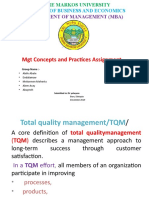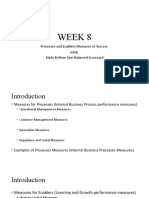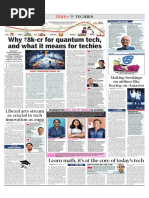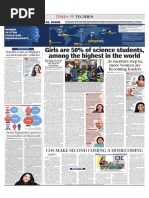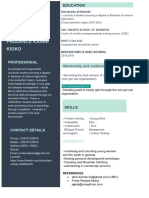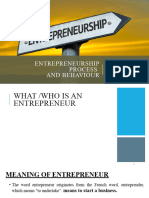0 ratings0% found this document useful (0 votes)
27 viewsModule 4
The document discusses various topics related to finance, accounting, management, and business including sources of finance, financial statements, human resource management, operations management, quality management, and supply chain management. It provides details on balance sheets, profit and loss accounts, inventory control methods, total quality management, change management, digital marketing, and other concepts.
Uploaded by
Raushan KashyapCopyright
© © All Rights Reserved
Available Formats
Download as PDF, TXT or read online on Scribd
0 ratings0% found this document useful (0 votes)
27 viewsModule 4
The document discusses various topics related to finance, accounting, management, and business including sources of finance, financial statements, human resource management, operations management, quality management, and supply chain management. It provides details on balance sheets, profit and loss accounts, inventory control methods, total quality management, change management, digital marketing, and other concepts.
Uploaded by
Raushan KashyapCopyright
© © All Rights Reserved
Available Formats
Download as PDF, TXT or read online on Scribd
You are on page 1/ 26
Module-IV
Functional Areas and Recent
Trends in Management
Sources of Finance
• Owners Fund: Issue of equity shares, Ploughed
back profits
• Borrow Fund: Debentures, Loans from financial
institutions
• Short Term Finance: Trade creditor, Advance from
customers, Instalment credit, Bank Overdraft
• Medium Term Finance: Commercial banks,
Debentures
• Long Term Finance: Equity shares, Leasing
Financial Statements
• Financial statements include income statements,
balance sheets, cash flow statements.
• It is standard practice for businesses to present
financial statements that adhere to generally
accepted accounting principles (GAAP).
• Financial statements are often audited by
government agencies, accountants, firms, etc. to
ensure accuracy for tax, financing and investing.
Balance Sheet
• A balance sheet is a financial statement that
summarizes a company's assets, liabilities and
shareholders' equity at a specific point in time.
• These three balance sheet segments give
investors an idea as to what the company owns
and owes, as well as the amount invested by
shareholders.
• The balance sheet adheres to the formula:
Assets = Liabilities + Shareholders' Equity
Profit and Loss Account
• Profit and Loss Account (P&L) is a financial statement
that summarizes the revenues, costs and expenses
incurred during a specific period of time, usually a
fiscal quarter or year.
• These records provide information about a company's
ability – or lack thereof – to generate profit by
increasing revenue, reducing costs, or both.
• The P&L statement is also referred to as "statement of
profit and loss", "income statement," "statement of
operations," "statement of financial results," and
"income and expense statement.“
Human Resource Management
(HRM)
“HRM is management function concerned
with hiring , motivating and maintaining
people in an organization. It focuses on
people in organization”
HRM FUNCTIONS
• Human resource planning
• Recruitment
• Selection
• Compensation & benefits
• Performance appraisal
• Training and development
• Employee relations
• Safety & health
7
Training and Development Methods
On-the job-training (OJT)
– learn while you’re working
Off -the job-training
– In house, training or classroom
– External, consultancies or attending external classes
– Independent bodies, such as government talks
– Distance learning, from books or notes
– Computer-assisted learning
– Interactive-video training
– Video conferencing, same as classroom except teachers and
students are in different locations.
Operations Management: Objectives
• To produce the goods as per the quality demanded by
the customers in most economic manner.
• To sustain and increase the level of customer
satisfaction.
• To make improvement in existing goods and services.
• To maintain inventory to avoid the blockage of
working capital .
• To ensure uninterrupted supply of goods and services.
• To keep proper maintenance of plant and machinery
Plant Layout
• Product / Line Layout
• Process / Functional Layout
• Combination / Mixed Layout
• Project / Stationary Layout
• Cellular / Group Layout
Site Selection
• Business location is an essential component in
its eventual success or failure.
• Site selection can be pivotal in all sorts of
businesses, including retail, service,
wholesale, and manufacturing efforts.
• Poor location is one of the primary causes of
business failure.
• Good business location can be enormously
beneficial to firms.
Factors Affecting Site Selection
• Availability of Raw Materials
• Availability of labour
• Availability of Power and Fuel
• Transport and Communication facilities
• Nearness to Market
• Political and economic situation
• Possibilities of future expansion
• Social Reactions
Productivity
• Productivity is a measure of how well resources
are utilized to produce output
• It relates output to input in any system, where
some value addition is performed on the input
resource
• Productivity is the ratio between “ Output of
Work “ and “Input of Resources “ used in the
“Process of Creating Wealth”--- ILO.
• It is the ratio between the amount Produced
(Output) and the amount of Resources (Input)
used in Production by eliminating Waste.
Inventory Control
• The term inventory means the value or amount of
materials or resource on hand.
• It includes raw material, work-in-process, finished
goods & stores & spares.
• nventory Control is the process by which
inventory is measured and regulated according to
predetermined norms such as economic lot size,
stock levels, safety stock, etc.
• Inventory control pertains primarily to the
administration of established policies, systems &
procedures in order to reduce the inventory cost.
Inventory Control Methods
• ABC Analysis
• This technique divides inventory into A, B & C
categories based on annual consumption value.
• It is the method of Selective Inventory Control.
• This method categorizes inventory items according
to the potential amount to be controlled.
• VED Classification: Vital, Essential & Desirable
• FSN Analysis: (Fast , slow & non) moving
• XYZ Analysis: (Negligible. Moderate & Maximum)
Variation
ABC Analysis
Total Quality Management (TQM)
• A core definition of total quality management
(TQM) describes a management approach to
long–term success through customer
satisfaction.
• In a TQM effort, all members of an
organization participate in improving
processes, products, services, and the culture
in which they work.
• TQM is also known as total productive
maintenance.
History of TQM
• TQM, in the form of statistical quality control,
was invented by Walter A. Shewhart.
• It was initially implemented at Western
Electric Company, in the form developed by
Joseph Juran.
• TQM was demonstrated by Japanese industry
through the intervention of W. Edwards
Deming—who, has come to be viewed as the
"father" of quality control, quality circles, and
the quality movement.
Change Management
• It is the creation and implementation of the roles, processes
and tools used to effectively manage the change.
• Phases of Change Management:
1. Preparing for Change:
• Define Change Management strategy.
• Prepare Change Management Team.
2. Managing Change.
• Develop Change Management Plans.
• Take action and Implement.
3. Reinforcing Change.
• Collect and analyse feedback.
• Diagnose gaps, manage resistance and rectify actions.
Supply Chain Management
• The term supply chain refers to the entire network of
companies that work together to design, produce, deliver,
and service products.
• It covers all activities associated with the flow and
transformation of goods from raw materials to end users.
• SCM involves:
1. Design, planning, execution, control, and monitoring of
supply chain activities
2. creating net value
3. building a competitive infrastructure
4. leveraging worldwide logistics
5. synchronizing supply with demand
6. measuring performance globally
Digital Marketing
• Digital marketing is an umbrella term for the
marketing of products or services using digital
technologies, mainly on the Internet, but also
including mobile phones, display advertising,
and other digital medium.
• Digital marketing revolves around 5Ds:
• digital devices, digital platforms, digital media,
digital data, and digital technology.
Management in Post-Covid Scenario
• Organizations shift to more remote work operations,
explore the critical competencies employees will need
to collaborate digitally
• Make sure to follow best practices to ensure
responsible use of employee information and
analytics.
• Evaluate how performance management systems
apply to contingent workers and determine whether
they will be eligible for the benefits.
• Promote physical health and improve the emotional
well-being of employees.
• Encourage employees to develop critical skills that
potentially open up multiple opportunities for their
career development
Business Ethics
• Business ethics is the study of appropriate business
policies and practices regarding potentially
controversial subjects including corporate governance,
insider trading, bribery, discrimination and corporate
social responsibility.
• Business ethics can be denoted as written or
unwritten codes of morals, values, and principles.
• It governs actions and decisions in a company.
• In the business world, standards are set for
determining good and bad behaviour and
decision-making.
• Business ethics leads to a more productive workplace.
• Three powerful transforming pillars of Ethics are
Character, Competence and Collaboration.
• They decide; what is right, ethical, logical and pragmatic.
• Advantages of Business Ethics
1. Provide competitive advantage & customer satisfaction
2. Improve employee happiness
3. Attract more investors
4. Better for society
• Bad business ethics lead to instance in which a company
knowingly ignores the best interests of its employees,
customers or the society for earning more money
Assignment-IV
1. Describe various functions of HRM.
2. Discuss different types of plant layout.
3. Explain the concept of digital marketing.
4. Write in brief:
a) Change Management
b) ABC Analysis
c) Business Ethics
d) Management in Post-Covid Scenario
You might also like
- Level 4 - Management Accounting Budgeting - Course Book100% (4)Level 4 - Management Accounting Budgeting - Course Book284 pages
- Marketing Management 4e (Print) : Juta - Co.za/pdf/2824220% (5)Marketing Management 4e (Print) : Juta - Co.za/pdf/282423 pages
- Chapter 1 - Approaches To Operational Auditing100% (1)Chapter 1 - Approaches To Operational Auditing7 pages
- Internal Audit + External Audit: Chap 6,7No ratings yetInternal Audit + External Audit: Chap 6,726 pages
- MGT Concepts and Practices Assignment: Department of Management (Mba)No ratings yetMGT Concepts and Practices Assignment: Department of Management (Mba)119 pages
- Week 8 - Lecture Slides - Process and Enablers Balanced ScorecardNo ratings yetWeek 8 - Lecture Slides - Process and Enablers Balanced Scorecard24 pages
- Chapter 1 - Approaches To Operational AuditingNo ratings yetChapter 1 - Approaches To Operational Auditing7 pages
- UNIT 4 Continuous Process Improvement TQM Dr. S B MALLUR PDFNo ratings yetUNIT 4 Continuous Process Improvement TQM Dr. S B MALLUR PDF70 pages
- CHAPTER-1-INTRODUCTION-TO-OPERATIONS-MANAGEMENT (1)No ratings yetCHAPTER-1-INTRODUCTION-TO-OPERATIONS-MANAGEMENT (1)50 pages
- 1 - Introduction For OSCM and ManagementNo ratings yet1 - Introduction For OSCM and Management29 pages
- Management Control System: Presented By: Ravish PrakashNo ratings yetManagement Control System: Presented By: Ravish Prakash33 pages
- Presentation On Performance Measurement of QualityNo ratings yetPresentation On Performance Measurement of Quality31 pages
- Marc Lester Jose Laureana Veronika S. VicedoNo ratings yetMarc Lester Jose Laureana Veronika S. Vicedo31 pages
- Productions and Operations ManagementpptNo ratings yetProductions and Operations Managementppt65 pages
- Operations Management: Semester 5 Session 2No ratings yetOperations Management: Semester 5 Session 230 pages
- Lecture 5 - Modern Operational Management TheoryNo ratings yetLecture 5 - Modern Operational Management Theory5 pages
- Chapter 1 - Managerial Accounting and The Business EnvironmentNo ratings yetChapter 1 - Managerial Accounting and The Business Environment48 pages
- Entrepreneurship & Engineering Management 18 - Mechanical EngineeringNo ratings yetEntrepreneurship & Engineering Management 18 - Mechanical Engineering20 pages
- Macc Maksi - How Management Accounting Information Support Decision MakingNo ratings yetMacc Maksi - How Management Accounting Information Support Decision Making31 pages
- Balance Scorecard and Its Application - PMNo ratings yetBalance Scorecard and Its Application - PM17 pages
- Operations Management: Session 4 Semester 5No ratings yetOperations Management: Session 4 Semester 526 pages
- Module 1 - Basic Concepts in Cost AccountingNo ratings yetModule 1 - Basic Concepts in Cost Accounting11 pages
- Management Control System: Presented By: Ravish PrakashNo ratings yetManagement Control System: Presented By: Ravish Prakash34 pages
- Process Management: Just in Time and Total Quality ManagementNo ratings yetProcess Management: Just in Time and Total Quality Management26 pages
- Laptops Made Transition To WFH Easy, But They Are Still ExpensiveNo ratings yetLaptops Made Transition To WFH Easy, But They Are Still Expensive1 page
- Why '8k-cr For Quantum Tech, and What It Means For Techies: Liberal Arts Stream As Crucial To Tech Innovation As EnggNo ratings yetWhy '8k-cr For Quantum Tech, and What It Means For Techies: Liberal Arts Stream As Crucial To Tech Innovation As Engg1 page
- Why Tech Companies Are Hiring People With Humanities DegreesNo ratings yetWhy Tech Companies Are Hiring People With Humanities Degrees1 page
- Work-From-Home Opens Many New Doors For Cyber Criminals: For First Time Ever, Freshers' First Day at Work Is at HomeNo ratings yetWork-From-Home Opens Many New Doors For Cyber Criminals: For First Time Ever, Freshers' First Day at Work Is at Home1 page
- How India's Helping Global Retail Take On The Amazon ChallengeNo ratings yetHow India's Helping Global Retail Take On The Amazon Challenge1 page
- 100% WFH: Techies & Companies Are Taking To It Like Fish To WaterNo ratings yet100% WFH: Techies & Companies Are Taking To It Like Fish To Water1 page
- Girls Are 50% of Science Students, Among The Highest in The WorldNo ratings yetGirls Are 50% of Science Students, Among The Highest in The World1 page
- Covid To Cancer: How AI Is Being Used To Beat Deadly DiseasesNo ratings yetCovid To Cancer: How AI Is Being Used To Beat Deadly Diseases1 page
- How AI Can Be Used To Solve Some of India's Biggest ProblemsNo ratings yetHow AI Can Be Used To Solve Some of India's Biggest Problems1 page
- WFH, Growing Need For Digital Skills Fuel On-Demand Job RolesNo ratings yetWFH, Growing Need For Digital Skills Fuel On-Demand Job Roles1 page
- Nestor Martel Journalj Ledger and Trial Balance Merged 3No ratings yetNestor Martel Journalj Ledger and Trial Balance Merged 37 pages
- Universities and Innovation Ecosystems - A Dynamic Capabilities PerspectiveNo ratings yetUniversities and Innovation Ecosystems - A Dynamic Capabilities Perspective19 pages
- Corporate Social Responsibility ProjectNo ratings yetCorporate Social Responsibility Project33 pages
- Calculus Early Transcendentals 11th Edition Anton Solutions Manual - Read Now With The Full Version Of All Chapters100% (2)Calculus Early Transcendentals 11th Edition Anton Solutions Manual - Read Now With The Full Version Of All Chapters56 pages
- Local Wisdom Based Cross Cultural ManagementNo ratings yetLocal Wisdom Based Cross Cultural Management18 pages
- Listening Practice Test 4: Questions 1-4No ratings yetListening Practice Test 4: Questions 1-413 pages
- (Ebook) Fundamentals of Cost and Management Accounting, 9th Edition by SR de Wet ISBN 9780639009742, 0639009743 - The ebook is ready for instant download and access100% (2)(Ebook) Fundamentals of Cost and Management Accounting, 9th Edition by SR de Wet ISBN 9780639009742, 0639009743 - The ebook is ready for instant download and access73 pages
- Level 4 - Management Accounting Budgeting - Course BookLevel 4 - Management Accounting Budgeting - Course Book
- Marketing Management 4e (Print) : Juta - Co.za/pdf/28242Marketing Management 4e (Print) : Juta - Co.za/pdf/28242
- MGT Concepts and Practices Assignment: Department of Management (Mba)MGT Concepts and Practices Assignment: Department of Management (Mba)
- Week 8 - Lecture Slides - Process and Enablers Balanced ScorecardWeek 8 - Lecture Slides - Process and Enablers Balanced Scorecard
- UNIT 4 Continuous Process Improvement TQM Dr. S B MALLUR PDFUNIT 4 Continuous Process Improvement TQM Dr. S B MALLUR PDF
- CHAPTER-1-INTRODUCTION-TO-OPERATIONS-MANAGEMENT (1)CHAPTER-1-INTRODUCTION-TO-OPERATIONS-MANAGEMENT (1)
- Management Control System: Presented By: Ravish PrakashManagement Control System: Presented By: Ravish Prakash
- Presentation On Performance Measurement of QualityPresentation On Performance Measurement of Quality
- Chapter 1 - Managerial Accounting and The Business EnvironmentChapter 1 - Managerial Accounting and The Business Environment
- Entrepreneurship & Engineering Management 18 - Mechanical EngineeringEntrepreneurship & Engineering Management 18 - Mechanical Engineering
- Macc Maksi - How Management Accounting Information Support Decision MakingMacc Maksi - How Management Accounting Information Support Decision Making
- Management Control System: Presented By: Ravish PrakashManagement Control System: Presented By: Ravish Prakash
- Process Management: Just in Time and Total Quality ManagementProcess Management: Just in Time and Total Quality Management
- Laptops Made Transition To WFH Easy, But They Are Still ExpensiveLaptops Made Transition To WFH Easy, But They Are Still Expensive
- Why '8k-cr For Quantum Tech, and What It Means For Techies: Liberal Arts Stream As Crucial To Tech Innovation As EnggWhy '8k-cr For Quantum Tech, and What It Means For Techies: Liberal Arts Stream As Crucial To Tech Innovation As Engg
- Why Tech Companies Are Hiring People With Humanities DegreesWhy Tech Companies Are Hiring People With Humanities Degrees
- Work-From-Home Opens Many New Doors For Cyber Criminals: For First Time Ever, Freshers' First Day at Work Is at HomeWork-From-Home Opens Many New Doors For Cyber Criminals: For First Time Ever, Freshers' First Day at Work Is at Home
- How India's Helping Global Retail Take On The Amazon ChallengeHow India's Helping Global Retail Take On The Amazon Challenge
- 100% WFH: Techies & Companies Are Taking To It Like Fish To Water100% WFH: Techies & Companies Are Taking To It Like Fish To Water
- Girls Are 50% of Science Students, Among The Highest in The WorldGirls Are 50% of Science Students, Among The Highest in The World
- Covid To Cancer: How AI Is Being Used To Beat Deadly DiseasesCovid To Cancer: How AI Is Being Used To Beat Deadly Diseases
- How AI Can Be Used To Solve Some of India's Biggest ProblemsHow AI Can Be Used To Solve Some of India's Biggest Problems
- WFH, Growing Need For Digital Skills Fuel On-Demand Job RolesWFH, Growing Need For Digital Skills Fuel On-Demand Job Roles
- Nestor Martel Journalj Ledger and Trial Balance Merged 3Nestor Martel Journalj Ledger and Trial Balance Merged 3
- Universities and Innovation Ecosystems - A Dynamic Capabilities PerspectiveUniversities and Innovation Ecosystems - A Dynamic Capabilities Perspective
- Calculus Early Transcendentals 11th Edition Anton Solutions Manual - Read Now With The Full Version Of All ChaptersCalculus Early Transcendentals 11th Edition Anton Solutions Manual - Read Now With The Full Version Of All Chapters
- (Ebook) Fundamentals of Cost and Management Accounting, 9th Edition by SR de Wet ISBN 9780639009742, 0639009743 - The ebook is ready for instant download and access(Ebook) Fundamentals of Cost and Management Accounting, 9th Edition by SR de Wet ISBN 9780639009742, 0639009743 - The ebook is ready for instant download and access








